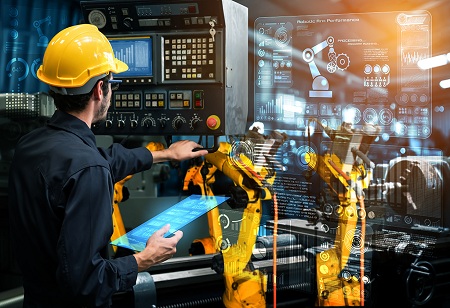
Robotics in manufacturing can outperform humans in terms of precision, consistency, and speed. It also lowers staff costs, enhances throughput, and improves safety. Furthermore, robots may be simply programmed to accomplish complicated tasks in a timely and correct manner. Robotics may also be utilized to automate the manufacturing process, allowing for more effective resource use and lowering the chance of human mistakes.
Furthermore, robots can be utilized in hazardous conditions such as high temperatures or dangerous places. This makes the workplace safer for employees and lowers the likelihood of accidents. Because of this enhanced safety and efficiency, robotics has become a vital tool in a variety of sectors. Although there are several benefits to robotics, there are also drawbacks to consider. The expense of investing in and sustaining a robotic workforce is one of the most significant drawbacks.
Robots are also not yet capable of replicating the whole spectrum of human talents, which means that some activities must still be done by people. There is also the fear that as robots get more advanced; they will eventually replace human employees totally, resulting in widespread unemployment. According to recent research, AI and robotics might possibly replace over 140 million jobs worldwide by 2036. AI (artificial intelligence) is the ability of a computer or robot to execute activities that normally require human intellect, such as interpreting spoken language and identifying objects. Let us now look at how robotics might help improve production efficiency and productivity.
Streamlined and Agile Production Processes
Robots are well-suited for repetitive and high-precision tasks that were traditionally performed by human workers. By deploying robots on the assembly line, manufacturers can streamline their production processes and achieve greater precision and consistency in product manufacturing. Unlike human workers, robots do not experience fatigue or require breaks, enabling them to work around the clock without compromising quality or output.
Furthermore, robots can be easily programmed and reprogrammed to adapt to changing production needs. This agility allows manufacturers to respond swiftly to market demands and product variations, reducing time-to-market and enhancing operational flexibility. Whether it's assembling intricate components, performing quality checks, or packaging finished goods, robots can execute tasks with remarkable speed and accuracy, significantly boosting overall efficiency and productivity.
For example, automotive manufacturers have successfully integrated robotics into their production lines to automate tasks such as welding, painting, and assembly. This has not only resulted in faster production cycles but also improved product quality through precise and consistent execution.
Enhanced Safety and Work Environment
Ensuring a safe work environment for employees is a top priority for manufacturers. Traditional manufacturing processes often involve hazardous tasks that put human workers at risk of injury or exposure to harmful substances. By introducing robots into the production floor, manufacturers can mitigate these risks and create a safer work environment.
Robots are designed to handle dangerous and physically demanding tasks, such as lifting heavy objects or working in high-temperature environments. By assigning these tasks to robots, manufacturers can protect human workers from potential injuries and health hazards. This, in turn, leads to a reduction in workplace accidents, lower workers' compensation costs, and improved employee morale.
Moreover, robots are equipped with advanced sensors and safety features that enable them to operate in close proximity to human workers without endangering their well-being. Collaborative robots, also known as cobots, are specifically designed to work alongside humans, providing additional support and assistance. This collaboration between humans and robots optimizes productivity while maintaining a safe and harmonious work environment.
“The advancement in technology has brought forward the perfect man-machine collaboration called collaborative robots or “cobots”. According to a survey, the global collaborative robots market is projected to grow from $1,358.2 million in 2021 to $16,387.3 million in 2028 at a CAGR of 42.7% in the forecast period.” Says Sougandh KM, Country Manager of India, Universal Robots.
Data-Driven Decision Making and Continuous Improvement
The integration of robotics in manufacturing brings about a wealth of data and insights that can be leveraged for data-driven decision-making and continuous improvement. Robots are equipped with sensors and vision systems that enable them to collect real-time data on various aspects of the manufacturing process, including quality control, cycle times, and equipment performance.
This data can be analyzed using advanced analytics tools and machine learning algorithms to identify patterns, detect anomalies, and optimize production processes. By gaining deep insights into the performance of the manufacturing line, manufacturers can make informed decisions to optimize efficiency, reduce waste, and improve overall productivity.
Additionally, the ability to monitor and analyze data in real time allows manufacturers to implement predictive maintenance strategies. By detecting equipment failures or signs of wear and tear in advance, manufacturers can schedule maintenance activities proactively, minimizing unplanned downtime and maximizing equipment utilization.
Furthermore, the data gathered from robots can be used to facilitate continuous improvement initiatives such as lean manufacturing and Six Sigma. By identifying bottlenecks, process inefficiencies, or quality issues, manufacturers can make targeted improvements and drive operational excellence.
Hence, robotics is revolutionizing the industrial business by increasing productivity and efficiency. Manufacturers may gain higher precision, consistency, and operational flexibility through simplified and agile manufacturing processes. Robot integration also contributes to a safer work environment by reducing dangers and safeguarding human workers. Furthermore, robots' data-driven insights help firms make educated decisions, optimize operations, and drive continuous improvement. As the use of robots in manufacturing expands, we may anticipate more improvements in efficiency and production, leading the sector toward a more inventive and competitive future.

